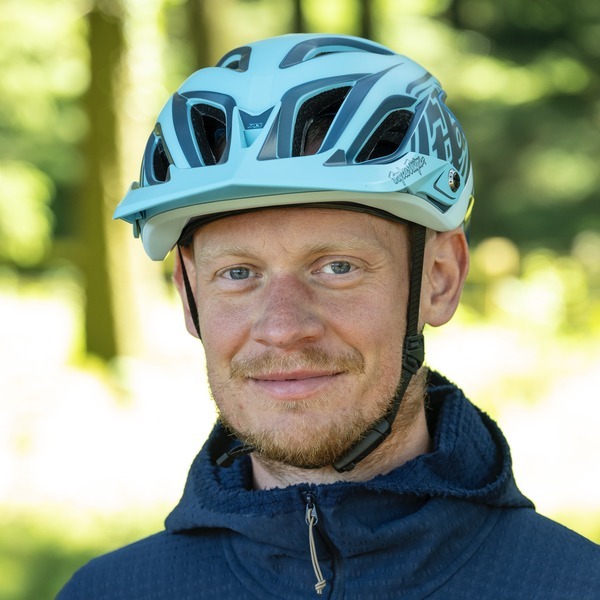Many brands launching new bikes go big on the model’s race-winning credentials, but with the new Anthem, Giant has every right to brag, with the overhauled cross-country platform ridden to victory on the biggest stage of all.
South African rider Alan Hatherly defended his UCI XCO Mountain Bike World Championship title in Valais in September. It was an impressive feat for both athlete and manufacturer, given that the 29-year-old only officially joined the Giant Off-Road Factory Team from Cannondale Factory Racing in January 2025, and that the bike was still a carbon prototype.
We were at the launch of the new Anthem, where Hatherly and Giant’s off-road category manager, Joe Staub shared how the Taiwanese manufacturer turned a middle-of-the-pack platform into a rainbow-jersey winning bike.
A fresh start

Giant’s previous-generation Anthem was launched in 2022, and while it had shown race-winning prowess – most notably under Dario Lillo during the 2024 season in the U23s – it was due for an update.
But with cross-country mountain bike trends evolving at pace, Staub knew it was time for a root-and-branch rethink of the platform.
“Internally at the company, we had effectively a mandate of we’ve really got to do things in a totally new way, otherwise, we're not going to initiate the project. We had to break our mould,” he says.
It wasn’t a fresh start solely for the product, though. It extended to the commercialisation process, going to market, target-setting and identifying the core user group. “It was a blank slate on how we approach delivering product, and how we'd approach creating products,” Staub adds.
Reinventing the wheel (and frame)

The result is a new Anthem that looks completely different from the previous generation. The shock has been moved below the top tube, opening up space for two bottles in the front triangle, while the frame itself is made from Giant’s Advanced SL carbon layup – combining the stiffness and lightness required to win on the biggest stages.
It also features a one-piece cockpit and internal cable routing, and all-new Giant XCR carbon wheels. Staub says these were key to the overall package: “The number one feature is our low-latency speed concept,” he explains.

“We wanted to be able to transmit rider input directly into the output that mattered, so no lag time between somebody like Alan [Hatherly] putting power down and realising a sprinting advantage – whether for a finish line or the inside of a corner to get into a downhill.”
To achieve this, Giant designed the wheels and frame together, ensuring they were able to balance weight and stiffness. “We chose where we spent the grams and where we chose stiffness and how transmission stiffness works between frame and rear wheel,” says Staub.

“We have really cool wheel technology called DBL [dynamic balanced lacing – a spoke-lacing technology] that allows us to have awesome transmission stiffness. We also have carbon spokes on the full-carbon version and a 120-tooth ratchet that is near-instant engagement.”
The front and rear wheels are tuned differently, too, to respond to the specific roles they perform.
“The rear has a totally unique requirement in the fact that it has to have a certain transmission stiffness for pedalling efficiency, but it also has to have a certain brake stiffness. The front wheel has brake stiffness only on one side, but we still have to be mindful of how it performs for lateral and vertical compliance.”

Further up the frame, in addition to the moving of the shock, the Anthem also features a flip chip for the first time – enabling minor adjustments to the geometry. Hatherly has already seen the benefits of when training and racing.
“I think it's really cool that you're able to change it on the fly and make the bike more capable and more suitable for the type of riding you're planning on doing,” he says.
“There's obviously the more pedally, flatter courses, like Lenzerheide, where you can get away with using the high position – it lifts the bottom bracket a bit, tightens the head angle a bit and allows you to pedal over terrain that you normally wouldn't be able to.
“If the courses are really long uphills and then straight down downhills, you can drop it into the low position and take advantage of the capabilities on the steep stuff when it gets a bit high-speed.”
Double trouble

The new release isn’t limited to the Anthem, but also includes a second model – the Anthem X. Packing a 130mm fork, and designed for going fast and far on trails and backcountry, Staub explains it’s made for the kind of riding he does, and hopes it appeals to those who aren’t yet ready for an ebike.
“In a lot of our markets, there's a trend towards riding off-road on an ebike, and there's tons of people that love that experience. I ride ebikes, too, and I like them,” he says.
“But in my heart, I'm a mountain biker and I know there's a lot of people that love the simplicity of taking a bike to its limit.
“I think with this bike, the range limit is psychological. We're not talking about racing between the tape – it's more of riding all day, riding very far, riding into the backcountry, riding into places that you may not know what the ride profile is going to be like but you want something to complement that effort.
“Over the last several years, there's been an enduro-ification of trail bikes that have pushed them to a lot more downhill capability, but they've lost some efficiency and snappiness in that, and they've become something that's more laborious to ride on.”
Hatherly adds that he’s excited to explore the bike’s potential during the off-season, as a potential ace up his sleeve in UCI World Cups: “I think [there are] certain courses where a 130mm fork could be beneficial. It's really cool to have that option for us.”
Race-led refinements

Trends in bike tech are driven by two factors:
- Course changes and the introduction of technical features such as rock gardens require alterations to the bike
- Athletes who are continually pushing to ride harder and faster
The new-generation Anthem is a response to these demands. “Guys like Alan [Hatherly] have identified the product needs because the racing needs are already there – he wants to win, we want to support him, it's pretty clear,” says Staub.
But Staub believes these pro-focused improvements have a trickle-down benefit for the average rider. “We want to start with making sure the performance is there for someone like Alan,” he explains.
“If we can't meet his performance needs, then what are we doing? I don't necessarily think his needs are at the detriment of a consumer – I think consumers can benefit from the same things.
“Of course, there are things he may need or things [where] he may have requirements that don't directly apply to a consumer. But that's also another reason why you see a bike like Anthem X rather than only an Anthem in the line-up.”

The Giant Factory Off-Road Team riders were consulted throughout the design process, but Hatherly became integral from V2 of the alloy prototype.
“We made a big jump in the suspension performance when we got Alan on board,” says Staub.
“That gave us the confidence in the product and the confidence in the process to effectively go forward into the carbon prototyping stage, and that's where he started to build even more value.”
Hatherly was keen to ride the alloy prototype at the Nové Město UCI World Cup in May, but had to settle for the previous-generation Anthem, before being given the first carbon prototype the following month in Val di Sole.
“When we get him a carbon bike, we're really looking for super-refined feedback,” says Staub.
“We want to validate all the stuff that he said was good to go in the aluminium prototyping stage. But then his feedback on a carbon prototype is super-valuable in that last 5 per cent, 3 per cent, 1 per cent as we go towards production.”
Internal decisions

The Anthem’s design isn’t based only on the wishes of Giant’s pro athletes, and its move to internal cable routing also taps into Staub’s previous life as a mechanic on the factory team and a desire to modernise mountain bikes aesthetically.
“If you look at the road bike side of things, we used to have cables running at a 90-degree angle out of shifters on road bikes and cables dangling in the breeze, and there was a modernisation,” he says.
“Now, it looks weird to see a road bike without completely concealed cables. Why shouldn't a mountain bike follow suit?
“I've been a mechanic for a long time, and it's always annoyed me to have things that are untidy on the front of the bike that's right in the view of the rider. When we went through the phase of having electronic shifting, you delete one of those cables, and then we moved into 1x drivetrains, and you delete the left shifter.”
Staub says the move to one-piece cockpits follows this trend: “Why shouldn't we extend that modernisation and aesthetic farther? It makes sense for us to do internal cable routing and integrated one-piece handlebars through our whole line-up. It's a little bit of a push, but why shouldn't we be the first?”
Future factors

Although the Anthem has only just been released, the constant drive for improvement means new ideas and concepts are never far from Staub’s thoughts.
In the immediate future, he believes the latest Anthem answers the questions posed by courses and athletes, but that change is always just around the corner.
“I feel confident that we've met the demands of racing now,” Staub says. “I know that racing will evolve and I look forward to meeting the demands of racing in the future.”





